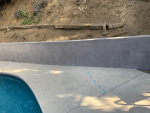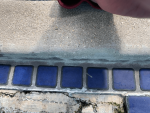Greetings,
Our pool was replastered 8 years ago by the previous homeowner. They poured a concrete deck that also serves as coping that cantilevers over the pool tile (see pics). It appears that they did not build this correctly as there is no urethane expansion joint between the tile and concrete coping/patio. The tiles have been falling off one by one for the past 5-6 years.
- What is the most affordable way to permanently fixed this?
- Can this be fixed without replastering the pool?
- how to determine if there is an appropriately sized joint between the tile and pool deck (can the grout be dug out? What should be the minimum measurement of this joint?
- if there is a decent size joint (that has been grouted over), can that be dug out so that a proper urethane joint could be applied?
Separate but related question. In reference to the photo showing the pool deck. We plan to cut the concrete along with blue tape so that we can build a timber deck to the right of the blue tape so that the deck is independent of the concrete pool deck in case we must replace the pool deck in the future (without harming the new timber deck). The contractor could cut the concrete along the blue tape. the narrowest width of the remaining concrete deck would be about 3 feet. Do you foresee any reason why we should NOT do this?
Thank you!
Our pool was replastered 8 years ago by the previous homeowner. They poured a concrete deck that also serves as coping that cantilevers over the pool tile (see pics). It appears that they did not build this correctly as there is no urethane expansion joint between the tile and concrete coping/patio. The tiles have been falling off one by one for the past 5-6 years.
- What is the most affordable way to permanently fixed this?
- Can this be fixed without replastering the pool?
- how to determine if there is an appropriately sized joint between the tile and pool deck (can the grout be dug out? What should be the minimum measurement of this joint?
- if there is a decent size joint (that has been grouted over), can that be dug out so that a proper urethane joint could be applied?
Separate but related question. In reference to the photo showing the pool deck. We plan to cut the concrete along with blue tape so that we can build a timber deck to the right of the blue tape so that the deck is independent of the concrete pool deck in case we must replace the pool deck in the future (without harming the new timber deck). The contractor could cut the concrete along the blue tape. the narrowest width of the remaining concrete deck would be about 3 feet. Do you foresee any reason why we should NOT do this?
Thank you!




